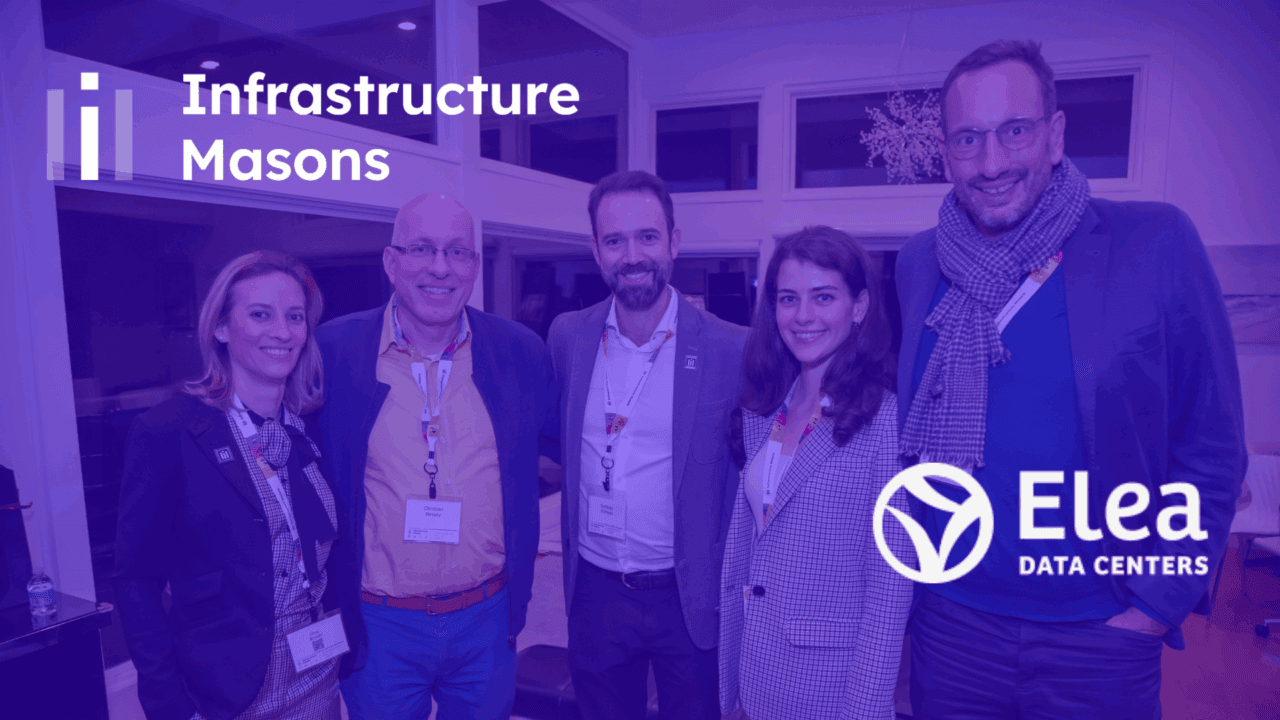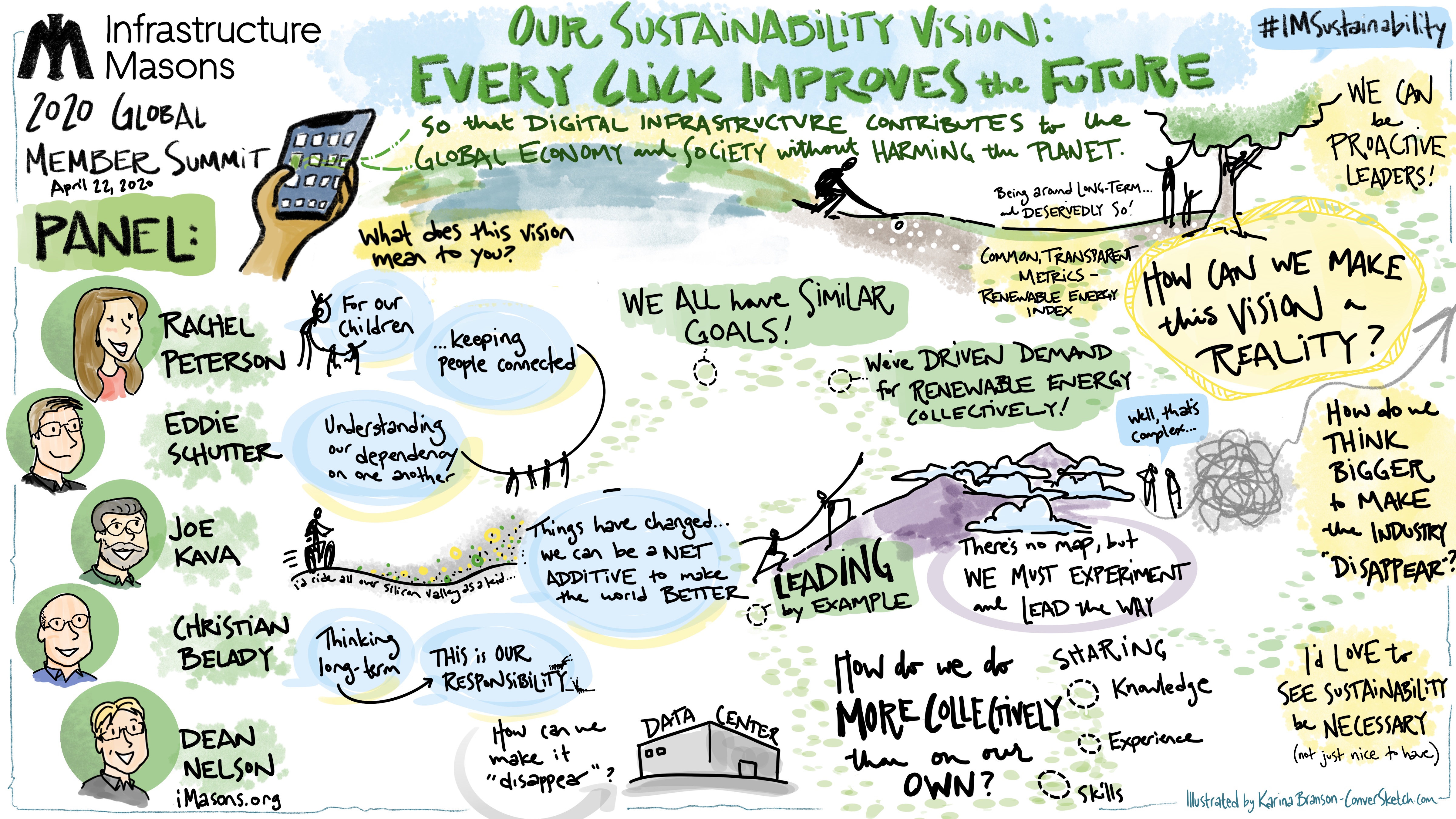- May 8, 2020
- Blog, Sustainability
Industry Leaders from Facebook, Google, Microsoft, and Switch Talk Sustainability
The Global Member Summit on Earth Day was a veritable buffet of insights from digital infrastructure industry leaders. In addition to two fireside chats, iMasons founder and chairman Dean Nelson facilitated a lively conversation with Christian Belady, GM of Data Center Services at Microsoft; Joe Kava, VP of Data Centers at Google; Rachel Peterson, VP of Data Center Strategy at Facebook; and Eddie Schutter, CTO at Switch.
Watch the full conversation and read the highlights below.
Highlights from the panel conversation
(Dean Nelson’s questions are in bold. Panelists’ responses are in quotes, which have been edited for clarity and length.)
What does Infrastructure Masons’ new sustainability vision “Every click improves the future” mean to you? Peterson said, “To me the sustainability vision is about the future for my children. Ensuring a safe and sustainable planet is really important.” For Belady, too, it’s about the long-term. He said, “For industry leaders there’s a responsibility for [ensuring a safe and sustainable future for our planet]. We owe it to our future. We owe it to humanity. When I interview people, I always ask what’s their definition of sustainability. One response in particular sticks with me: ‘Sustainability is to be around for the long term, and deservedly so.’”
Schutter explained, “This vision forces me to think about what I do in work life, as I make decisions, but also how do I behave and act and what becomes the unified compass we all follow in order to drive sustainability as a best practice in our daily lives. It’s not about shaming people or companies into performing a certain way. It’s about unifying around a common set of goals and ideas that lead to a brighter future for all of us.”
“It’s about unifying around a common set of goals and ideas that lead to a brighter future for all of us.”
Click to tweet
On leading by example: “The companies we work for and the roles we play afford us the opportunity to lead by example,” said Kava. “At Google we’ve been pioneering the move toward renewable energy for over a decade. Along the way one of our internal principles was that whatever we do, whether public policy or advocacy, we wouldn’t do on behalf of only Google, but on behalf of any company that wanted to follow suit and procure or purchase renewable energy to power their operations. As large power customers we have a big voice. That’s an area where we’ve been able to amplify our voice and help others follow suit.”
“We’ve done a lot of the same with other operational things we’ve worked on. Like AI/machine learning models that help us improve operations. Just today we announced development of an AI-based program that shifts workloads to times of the day when we’re consuming the most renewable energy. All of those things can flow through to other companies in the industry, big and small. It’s not just for our own benefit but for others’ as well.”
“As large power customers we can amplify our voice and help others follow suit.” Click to tweet
On working together: “What’s striking to me is that all of our objectives as individual companies are very similar,” said Peterson. “We’re fortunate to work at companies where we do have the ability to make an impact. At Facebook one of our goals is to foster innovation and transparency in the industry. For example, the Open Compute Project was an effort to share our open designs in order to drive efficiencies and improvements across the industry. We had smaller companies saying ‘I wouldn’t have known how to do this on my own but this has enabled me to reduce energy usage.’
“Similarly, on our renewable energy program we wanted to make it open for others. We set out to drive green tariff adoption in states that didn’t have ways for companies to achieve renewable energy. That opened up procurement in those states and also spurred renewable energy projects in those states. We see success. Five or ten years ago renewable energy was very expensive – prohibitively expensive for some companies – and it was very difficult to acquire. Now what you’ve seen is the shifting of supply and demand through these efforts. In a lot of places we’re now seeing renewable energy exceed coal at rates that are less than brown power rates. It underscores the importance of us as industry partners driving towards these common goals because together we can achieve so much more than individually.”
“Our success with renewable energy underscores the importance of us as industry partners driving towards these common goals.” Click to tweet
On being proactive: “I am proud that in this industry we’ve been largely self-governed,” said Kava. “With PUE, for example, we took it on ourselves as an industry. We had a vested interested in reducing PUE because it was good for the business. It made dollars and sense. We did this long before any regulator told us to reduce PUE. What happens when regulators put mandates or targets on us? They’re not experts and often targets are set without enough information. We can be out in front of this and once again help the industry self-govern.”
On having a renewable energy or sustainability index: “What I liked about PUE is it’s like a golf score – better among friends than in a tournament,” explained Schutter. “An index offers an opportunity to show as an industry this is what we consider a sustainable operation. For example, for every kilobyte process or gigabyte of storage or whatever the data points are for digital infrastructure, they can translate to carbon impact or carbon storage or whatever. You can figure out how to calculate that in your own environment and start working towards improving it without putting yourself or your company in a place of shame. The goal is for us to positively help each other improve our industry. Collectively we build a better industry and have a much bigger impact if we approach it that way.”
Belady, who co-created the PUE metric, said, “Eddie is right on the mark. PUE came about because I had recommended to a customer to make certain changes to the data center. They did the things that are basics today but we were pushing back then – hot aisle/cold aisle, etc. Three months later they said ‘Nothing’s changed except no one wants to work here now (too hot)!’ The temperatures were the same but they were operating more efficiently. But they didn’t know how to measure that. They couldn’t just measure power because the capacity of the data center had changed. So PUE came about to show the customer that they had improved. That was the power of the metric. It wasn’t about comparing to others. Metrics should be about how to get better than we were before.”
“Metrics should be about how to get better than we were before.” Click to tweet
Get involved
If you’re interested in participating in Infrastructure Masons’ sustainability initiatives – either providing your feedback during an upcoming Summit or as a member of the Sustainability Committee – you can do so via the new iMasons app. (If you don’t yet have the app, learn about it here. It’s free for all members.)
Learn more
Check out our other posts from the Spring 2020 Global Member Summit:
• The Impact of COVID-19 on Digital Infrastructure
• Our Sustainability Vision: Every Click Improves the Future
• Fireside Chat with Google’s Sustainability Officer Kate Brandt
• Fireside Chat with Microsoft Corporate VP Noelle Walsh-Elwell
And there’s more to come, so check back soon!

